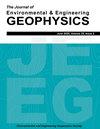非饱和砂的高频电磁感应响应:储罐规模的可行性研究
IF 0.7
4区 工程技术
Q4 ENGINEERING, GEOLOGICAL
引用次数: 3
摘要
对工程土壤特性的复杂电导率和复杂介电常数进行远距离电磁感应(EMI)测量,有可能彻底改变美国陆军处理路线规划和基础设施评估的方式。基于无人机系统(UAS)的土壤探测EM平台将在各种应用中产生广泛的影响,包括:民用基础设施检查、战区进出路由、减少IED探测中的误报、永久冻土测绘等。传统的频域EMI仪器在低频评估电导率,通常在1-20 kHz范围内;然而,最近的进步已经导致仪器瞄准宽带频率范围,从10khz到20mhz。这一进步被称为高频电磁感应(HFEMI),它可以通过获取土壤二次场的同相和正交响应来评估土壤的频域松弛效应。弛豫现象,如诱导极化和介电介电常数与重要的土壤性质有关,可以利用该HFEMI系统进行潜在的开发。虽然使用EMI响应的正交分量进行电导率测量在EMI仪器中已经很好地建立了,但对直接电测量和对峙HFEMI测量之间的关系的理解还很缺乏。为了在适合土壤性质估计的尺度上阐明各种电和电磁方法之间的这种关系,我们使用电地电方法(ERT, IP),电磁学,时域反射法(TDR)和探地雷达(GPR)进行并排测量。我们比较了HFEMI获得的ERT、IP、TDR和GPR测量的正交和同相响应。开发了一个罐级测试单元,用于比较上述方法,并允许在不同饱和水平下评估砂土。此外,还评估了砂面以上不同高度的HFEMI响应。定性观察报告在初步尝试将HFEMI响应与重要土壤参数联系起来。本文章由计算机程序翻译,如有差异,请以英文原文为准。
Standoff High-Frequency Electromagnetic Induction Response of Unsaturated Sands: A Tank-Scale Feasibility Study
Standoff electromagnetic induction (EMI) measurements of complex conductivity and complex permittivity for engineering soil properties have the potential to revolutionize the way the US Army handles route planning and infrastructure assessment. An unmanned aerial system (UAS) based EM platform for soil interrogation would have wide reaching impact in a variety of applications including: civil infrastructure inspection, in-theater ingress and egress routing, reduction of false positives in IED detection, and permafrost mapping, among many others. Traditional frequency domain EMI instruments assess conductivity at low-frequencies, generally in the range of 1–20 kHz; however, recent advancements have resulted in instrumentation targeting a broadband range of frequencies, from 10 kHz through 20 MHz. This advancement, known as high-frequency electromagnetic induction (HFEMI) allows the potential to evaluate frequency domain relaxation effects in soils by acquiring both the in phase and quadrature response of the secondary field from the soil. Relaxation phenomena such as induced polarization and dielectric permittivity are related to important soil properties that can potentially be exploited using this HFEMI system. While conductivity measurements using the quadrature component of the EMI response are well established in EMI instrumentation, understanding of the relationship between direct electrical measurements and standoff HFEMI measurements is lacking. In an effort to illuminate this relationship between various electrical and electromagnetic methods at a scale suitable for soil property estimation, we perform side-by-side measurements using galvanic geoelectrical methods (ERT, IP), electromagnetics, time-domain reflectometry (TDR) and ground penetrating radar (GPR). We compare HFEMI obtained quadrature and in-phase responses to ERT, IP, TDR and GPR measurements. A tank-scale test cell was developed for comparison of the above methods and allowed assessment of sand at varying saturation levels. Further, the HFEMI response at varying heights above the sand surface was also assessed. Qualitative observations are reported in an initial attempt to relate the HFEMI response to important soil parameters.
求助全文
通过发布文献求助,成功后即可免费获取论文全文。
去求助
来源期刊

Journal of Environmental and Engineering Geophysics
地学-地球化学与地球物理
CiteScore
2.70
自引率
0.00%
发文量
13
审稿时长
6 months
期刊介绍:
The JEEG (ISSN 1083-1363) is the peer-reviewed journal of the Environmental and Engineering Geophysical Society (EEGS). JEEG welcomes manuscripts on new developments in near-surface geophysics applied to environmental, engineering, and mining issues, as well as novel near-surface geophysics case histories and descriptions of new hardware aimed at the near-surface geophysics community.
 求助内容:
求助内容: 应助结果提醒方式:
应助结果提醒方式:


